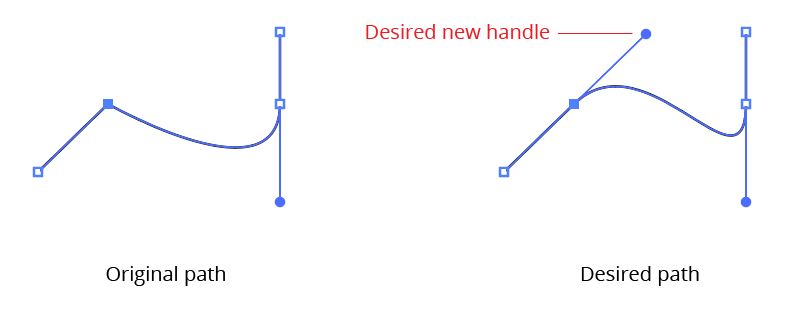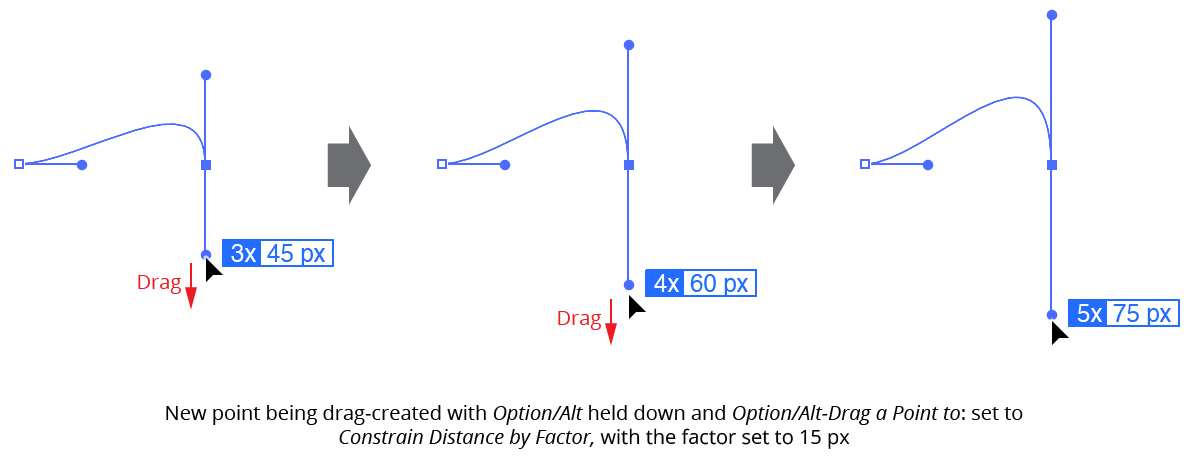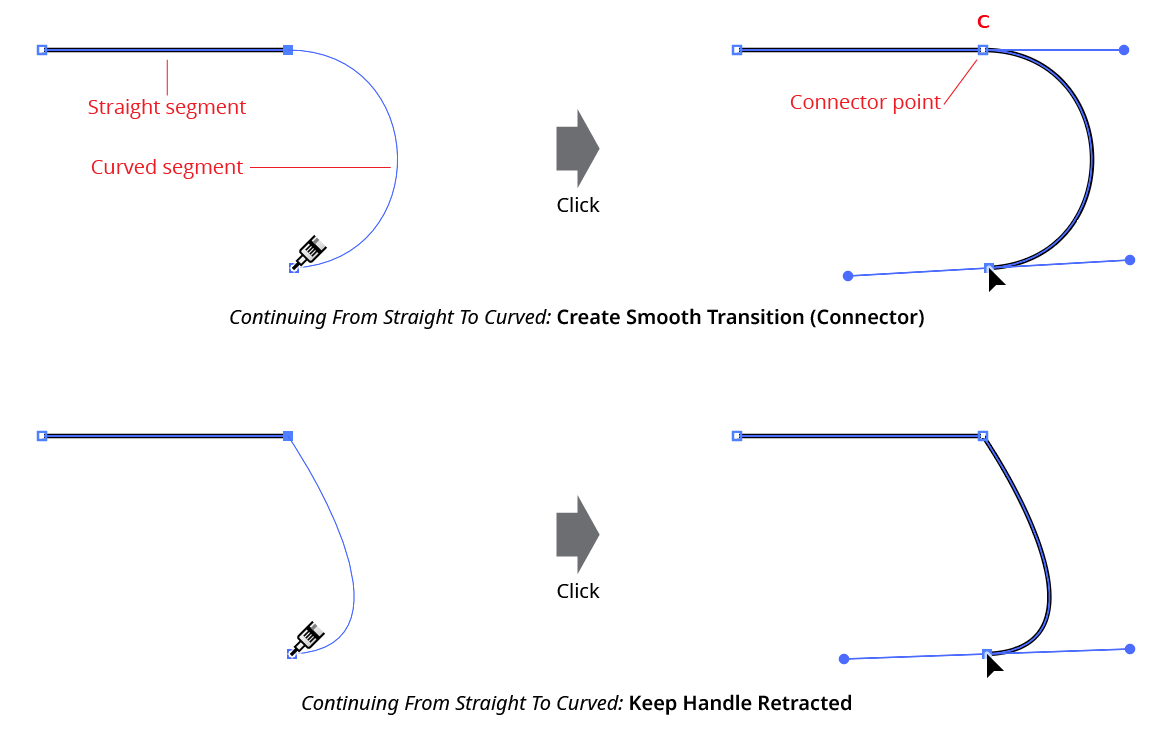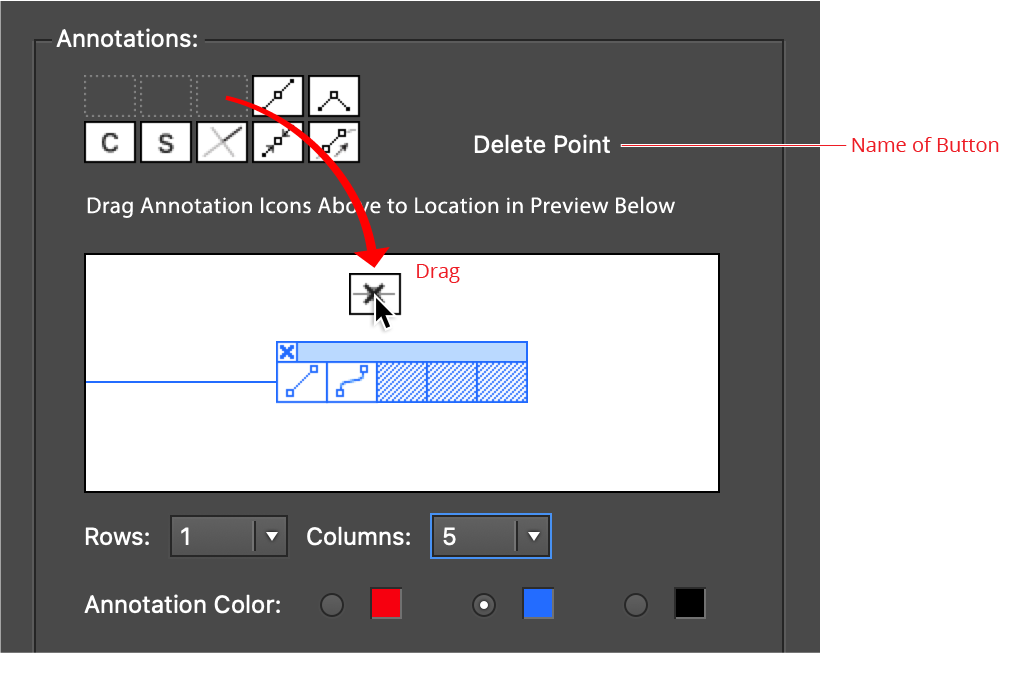 InkScribe Preferences
InkScribe Preferences
Using the flyout menu of the InkScribe panel, doubleclicking the InkScribe tool in the toolbox, or pressing the Enter key when the tool is selected will bring up the InkScribe preferences dialog:

InkScribe Preferences
1. Show All Handles on Path
When enabled, selecting one path segment will cause all path segments to become selected, thereby making their handles visible. This option should be used with caution, because it makes it impossible to select a single anchor point and move it in isolation using the arrow keys (because selected path segments are also moved).
2. Show Ghost Handles
3. On Current Segments Only
“Ghost handles” are virtual handles that can be converted to real handles by simply dragging them. They appear as small dim circles along the path. Dragging a ghost handle is often the easiest way to extend a single handle from an anchor point. For example, suppose you wanted to change the second point of this path into a connector point, with a single handle:

InkScribe Preferences - Ghost Handles Example 1
Dragging the middle path segment would create the handle, but would also move the existing handle. Dragging the selected point with the native Convert Anchor Point tool or Option/Alt-dragging it with the InkScribe tool would create two new handles, so one of them would subsequently need to be deleted. But by using ghost handles, a single click-and-drag with the tool is all that is required:

InkScribe Preferences - Ghost Handles Example 2
When On Current Segments Only is disabled, ghost handles will appear on all segments of the selected path(s) where they are available, instead of just the selected segments.
4. Option/Alt-Clicking Inserts New Points in Path
5. Snap to Tangencies
6. Highlight Tangencies
When Option/Alt-Clicking Inserts New Points in Path is enabled (the default), hovering the cursor over an existing segment of a selected path and Option/Alt-clicking will insert a new anchor point along that segment. If the sub-preference Snap to Tangencies is enabled, the cursor will snap to vertical, horizontal and diagonal tangencies on the path segment (taking into account the general constrain angle). A red guide will appear when the cursor is snapping, indicating the tangent direction. Additionally, you can choose to highlight all of the tangencies on the current path segment with a small magenta dot by enabling the Highlight Tangencies sub-preference. See InkScribe Tool: Path Segment Operations.
7. Option/Alt-Click on Points to:
This preference specifies the tool behavior when holding down the Option/Alt key and clicking on an anchor point. The default behavior is to delete the point (i.e., Smart Remove it; see InkScribe Tool: Existing Point Operations), but this can be changed to simply select it (in which case the panel’s Smart Remove button can still be used to delete points).
8. Option/Alt-Drag a Point to:
This preference specifies the tool behavior when holding down the Option/Alt key and click-and-dragging either a path endpoint or a continuing point. When set to Define Out Handle (the default), the drag creates the Out handle independently of the In handle (if any), like the native Pen tool. The point’s type will be changed to corner. When continuing a path, if Option/Alt was pressed subsequent to the start of the drag, then the point’s In handle will be kept at whatever location it had when Option/Alt was held down.

InkScribe Preferences - Define Out Handle
When the preference is set to Constrain Distance by Factor, then the length of the new handles will be constrained to a multiple of the specified factor. For example, if the factor is set to 15 px, then the new handles could be made 15 px, 30 px, 45 px, etc. but not in-between values. While the cursor is being dragged, and annotation will show the total handle length and the multiple by which the factor has been multiplied to produce that length:

InkScribe Preferences - Constrain by Factor
Constrain Distance by Factor also works when simply positioning a continuing anchor point with the mouse button up.
9. When Creating New Points, Ignore Drags of Less Than:
When working with a tablet and stylus, it can be difficult to click-place a new handleless anchor point by tapping the stylus, because these input devices often record a small drag after the click. By enabling this preference, drags of less than the specified distance are ignored. Very short handles can still be created by dragging them by a distance that exceeds the tolerance and then dragging the cursor back towards the anchor point. The Ignore distance value can be set between 2 and 72 pt, with a default of 10 pt.
10. Single-Click Point Creation Retracts Handles
When enabled (the default), clicking without dragging to create a new anchor point always results in a point without handles. Otherwise, whether the point is assigned handles depends on the type of segment that was selected in the InkScribe panel or virtual panel: if set to Straight Segment, the point will not have handles, whereas if set to Curved Segment, it will.
11. Make Points With Opposed Handles Smooth
When enabled (the default), points created by dragging to create two 180° opposed handles will always be created as smooth points.
12. Allow Auto-Adjustment of Previous Handles
If Single-Click Point Creation Retracts Handles is disabled, and a path is created using curved segments where each point clicked but not dragged, handles are automatically generated for each point. When Allow Auto-Adjustment of Previous Handles is enabled, each time an anchor point is added, handles on the previous point are automatically changed to produce a smoother path (for smooth points) or cusps (or corner points).

InkScribe Preferences - Auto Adjustment
13. Continuing From Straight To Curve:
Determines how Out handles of anchor points which change between straight and curved segments are handled. The default setting is to Create Smooth Transition (Connector). This adds a handle such that the transition between the straight segment and the curved segment is smooth (the point becomes a connector point, if connector recognition is enabled). The preference can also be changed to Keep Handle Retracted (as per the Pen tool), which will leave the handle retracted, thereby create a sharp change in direction at the point in question.

InkScribe Preferences - Straight to Curved Behavior
14. Click-Drag Segment to Reshape
15. Keep Path Under Cursor When Dragging
Click-Drag Segment to Reshape is enabled by default; it allows you to reshape an existing path segment simply by dragging it. With the preference disabled, the InkScribe tool will instead add a point when clicking/dragging on a path segment, with or without Option/Alt pressed. The sub-preference Keep Path Under Cursor When Dragging controls how the path is reshaped; if disabled, handles are still moved relative to the initial click location, but the path will not necessarily pass through the cursor position.
16. Connector Threshold
Specifies the number of degrees that the angle of a potential connector point can deviate from the ideal and still be recognized as a connector point. Allowed values range from 1° to 180°; the default is 5°. See Connector Points.
17. Smart Smooth Threshold
Specifies the number of degrees that the angle of a handle can deviate from the ideal (180° opposed from the other handle) and still be considered for smart smoothing. Allowed values range from 1° to 180°; the default is 5°.
18. Annotation Configuration Area
The virtual panel annotation is configured in this area. A button can be added to an empty slot by dragging it from the top section to the lower section. Buttons can be removed by dragging them out of their slot. The virtual panel may contain any or all of the ten standard panel buttons, in any order. The color and configuration of the virtual panel in the preview area reflect the current settings below it.

InkScribe Preferences - Virtual Path Configuration
19. Rows and Columns
Specify number of rows and columns in the virtual panel, with a maximum of ten for each. After the dialog is closed, rows and columns that contain no buttons will automatically be removed. The default is to have one row of five columns, containing the top five buttons from the panel.
20. Annotation Color
Chooses the color in which the virtual panel and snapping ring/point type identifier annotations are drawn (either red, blue or black). The default is blue.
21. Show Close Annotation Button
Shows the small “X” button which allows the virtual panel to be hidden for the current anchor point by clicking on it. If a new anchor point is drawn, the virtual panel will reappear. To hide it for all points, use the Annotations checkbox on the InkScribe panel.
22. Show Reposition Drag Bar
Shows the bar at the top of the virtual panel which allows it to be repositioned on the screen.
23. Show Point Leader Line
Shows the thin leader line which indicates which point on which the virtual panel is currently basing its settings (such as point type).
24. Annotation Location
Specifies the location of the annotated virtual panel. By default, the location is automatically determined, in a method that attempts to keep it from covering the likely path continuation. But a specific orientation relative to the anchor point can also be chosen through the 9-point grid control. As long as the preference Show Reposition Drag Bar is enabled, the virtual panel can be manually repositioned by dragging it.
25. Distance From Point
Specifies the distance that the virtual panel is initially placed from the selected anchor point. The default is 200 pixels, but can range from 5 to 500 pixels.
26. Delay Annotation Display
When enabled, the display of the virtual panel will not appear until the specified number of seconds has passed after creating or click-selecting an anchor point. This can help avoid distraction when drawing a path quickly. The delay can range from 0.1 seconds to 10 seconds.
27. No Delay On Selection
Available when Delay Annotation Display is enabled. It allows the virtual panel to come up immediately when click-selecting an anchor point but still have a delay when creating a new anchor point.
28. Hover For Point Identification
29. Boxed Style
When Hover For Point Identification is enabled, a ring is drawn around the anchor point that the InkScribe tool is snapping to, with its type (smooth or corner) also annotated. When Boxed Style is enabled, the point identification text is drawn in a box rather than in larger type adjacent to the ring.

InkScribe Preferences - Point Identification
30. Settings Manager
The Settings Manager popup menu provides access to saving, managing, and applying preference settings.

InkScribe Settings Manager
A. Save Settings...
When you save the preference settings, all of the current settings in the preferences dialog are captured in a file which can be recalled later. The file name may be specified.
B. Manage Settings...
Brings up the Manage Settings dialog, which lets you rename or delete existing settings files:

InkScribe Manage Settings Dialog
C. Settings List
Choosing a settings file from this list will change the preference settings to match the state of the dialog when the settings file was saved (or, the case of “[Default]”, to the default values). When the InkScribe plugin is first installed, a number of settings files will automatically be added. These may be used as-is or as the starting point for a custom set of preferences.
31. Help Button
Opens the help documentation in the Astute Manager. If this does not automatically appear, please ensure your Astute Manager is running first.
